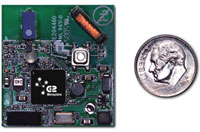
G2 Microsystems announced last week the release of an active RFID tag that also transmits data from a variety of sensors. This company is different in that they've designed their own chip that's used in their tags, and all they make are tags. Use of the Wi-Fi standard for RTLS will continue to drive specialization and interoperability, increasing performance, flexibility, and reducing costs.
The G2C501 system-on-chip also uses significantly less power than
comparable products, said the Campbell, California-based company. An
RFID tag with a G2C501 chip would last about five years at a 40-second
report rate with two AA batteries. Current tags with the same
configuration are only lasting a few months, said G2.
The new chip has a 125KHz receiver built in that lets users determine
the location of a tagged product within 3 meters. The chip also has EPC
support, which means it can also be used to operate within a passive
RFID tag.
It seems that G2 has broken a couple of barriers. The 5 year battery life sounds very promising, although a 40 second report rate is too long for many hospital applications. They report battery life of a bit less than one year at approximately a 15 second report rate. Even a 1 year battery life would be a milestone for an 802.11 tag. The other barrier is cost - they report that the tags will cost as little as $12 in high volume quantities. It also seems, from the photo at right, that the board is quite a bit smaller than two AA batteries.
Accuracy can be improved using the ISO 24730-2 mode, which will reportedly provide accuracy within 3 meters.
is in the final process of being ratified). This standard is a
superset of the ANSI 371.1 TOA protocol which was designed for asset
tracking and has been shipping in products for a number of years. When
using this protocol, the tag transmits 0dBm blinks with a 60MHz
bandwidth using a DSSS modulated 2.4GHz ISM band carrier. Tags can be
programmed using a magnetic data link, with a 2.4GHz OOK/FSK modulation
scheme for command acknowledgement. The tag also sends specific
DSSS-modulated signals when receiving signals from a magnetic
choke-point transmitter.
The other big news here is the ability to support sensor based data and transmit that data in addition to reporting position. Sensors currently supported include motion, temperature, security seal integrity, shock, humidity, radiation and pressure. Wouldn't it be nice if your asset tag told you when someone knocked over your IV pump? Waking up the tag upon movement could extend battery life in some applications.
Like some other RTLS vendors, G2 claims wildly optimistic savings through the use of existing 802.11 infrastructure. Of course your mileage will vary based on the kind of site survey you did when you installed your WLAN. There is a big savings here, but it's in the tags more than the infrastructure.
All in all, the G2C501 is a pretty impressive first product for a start up. There will surely be (some, not all) applications in health care where G2's tags will hit the sweet spot - time will tell which ones they are.


Recent Comments